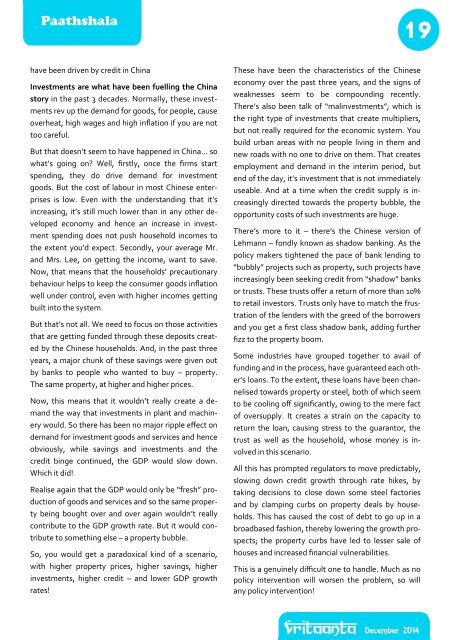Vritaanta December 2014
The Monthly Magazine of SIBM Pune
The Monthly Magazine of SIBM Pune
Create successful ePaper yourself
Turn your PDF publications into a flip-book with our unique Google optimized e-Paper software.
Paathshala<br />
19<br />
have been driven by credit in China<br />
Investments are what have been fuelling the China<br />
story in the past 3 decades. Normally, these investments<br />
rev up the demand for goods, for people, cause<br />
overheat, high wages and high inflation if you are not<br />
too careful.<br />
But that doesn’t seem to have happened in China… so<br />
what’s going on? Well, firstly, once the firms start<br />
spending, they do drive demand for investment<br />
goods. But the cost of labour in most Chinese enterprises<br />
is low. Even with the understanding that it’s<br />
increasing, it’s still much lower than in any other developed<br />
economy and hence an increase in investment<br />
spending does not push household incomes to<br />
the extent you’d expect. Secondly, your average Mr.<br />
and Mrs. Lee, on getting the income, want to save.<br />
Now, that means that the households’ precautionary<br />
behaviour helps to keep the consumer goods inflation<br />
well under control, even with higher incomes getting<br />
built into the system.<br />
But that’s not all. We need to focus on those activities<br />
that are getting funded through these deposits created<br />
by the Chinese households. And, in the past three<br />
years, a major chunk of these savings were given out<br />
by banks to people who wanted to buy – property.<br />
The same property, at higher and higher prices.<br />
Now, this means that it wouldn’t really create a demand<br />
the way that investments in plant and machinery<br />
would. So there has been no major ripple effect on<br />
demand for investment goods and services and hence<br />
obviously, while savings and investments and the<br />
credit binge continued, the GDP would slow down.<br />
Which it did!<br />
Realise again that the GDP would only be “fresh” production<br />
of goods and services and so the same property<br />
being bought over and over again wouldn’t really<br />
contribute to the GDP growth rate. But it would contribute<br />
to something else – a property bubble.<br />
So, you would get a paradoxical kind of a scenario,<br />
with higher property prices, higher savings, higher<br />
investments, higher credit – and lower GDP growth<br />
rates!<br />
These have been the characteristics of the Chinese<br />
economy over the past three years, and the signs of<br />
weaknesses seem to be compounding recently.<br />
There’s also been talk of “malinvestments”; which is<br />
the right type of investments that create multipliers,<br />
but not really required for the economic system. You<br />
build urban areas with no people living in them and<br />
new roads with no one to drive on them. That creates<br />
employment and demand in the interim period, but<br />
end of the day, it’s investment that is not immediately<br />
useable. And at a time when the credit supply is increasingly<br />
directed towards the property bubble, the<br />
opportunity costs of such investments are huge.<br />
There’s more to it – there’s the Chinese version of<br />
Lehmann – fondly known as shadow banking. As the<br />
policy makers tightened the pace of bank lending to<br />
“bubbly” projects such as property, such projects have<br />
increasingly been seeking credit from “shadow” banks<br />
or trusts. These trusts offer a return of more than 10%<br />
to retail investors. Trusts only have to match the frustration<br />
of the lenders with the greed of the borrowers<br />
and you get a first class shadow bank, adding further<br />
fizz to the property boom.<br />
Some industries have grouped together to avail of<br />
funding and in the process, have guaranteed each other’s<br />
loans. To the extent, these loans have been channelised<br />
towards property or steel, both of which seem<br />
to be cooling off significantly, owing to the mere fact<br />
of oversupply. It creates a strain on the capacity to<br />
return the loan, causing stress to the guarantor, the<br />
trust as well as the household, whose money is involved<br />
in this scenario.<br />
All this has prompted regulators to move predictably,<br />
slowing down credit growth through rate hikes, by<br />
taking decisions to close down some steel factories<br />
and by clamping curbs on property deals by households.<br />
This has caused the cost of debt to go up in a<br />
broadbased fashion, thereby lowering the growth prospects;<br />
the property curbs have led to lesser sale of<br />
houses and increased financial vulnerabilities.<br />
This is a genuinely difficult one to handle. Much as no<br />
policy intervention will worsen the problem, so will<br />
any policy intervention!<br />
<strong>December</strong> <strong>2014</strong>






